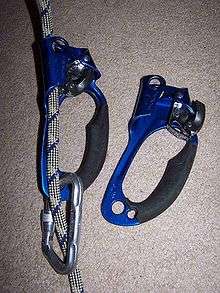Ascender (climbing)

An ascender is a mechanical device used for ascending on a rope. One such device is a Jumar, named after the two inventors, Jurgen (Ju) and Walter Marti (mar) and their Swiss factory which developed the first tool for sale in 1958. The device's name also leads to the term Jumaring for the process of using such a device. Other terms for this process include ascending, prusiking and jugging.[1]
Ascenders offer similar functionality to friction knots, but are faster and easier to use, albeit with consequences in security (as ascenders can, even with a locking carabiner, come off the rope, and fail by shredding the rope at high loads, rather than slipping and fusing as with friction knots). An ascender employs a cam which allows the device to slide freely in one direction (usually the intended direction of movement), and provide a firm grip on the rope when pulled on in the opposite direction. To prevent an ascender from accidentally coming off the rope, a locking mechanism or trigger is deployed. The ascender is first attached to the climber's harness by a piece of webbing or sling, and then is clipped onto the rope and locked. For climbing on a fixed rope attached, for example, to snow anchors on a steep slope, only one ascender is used, keeping the other hand free for holding an ice axe.
Jumaring, also referred to as jugging, is where the second climber (the one who belays the lead climber on the route) uses ascenders to climb the rope instead of climbing directly on the rock. Along with the ascenders, one or more webbing "ladders" called étriers (or aiders) are typically used to allow climbers to use their feet to step up and pull themselves up the rope.
Ascending is not typically performed on free climbing routes where a climber uses his or her hands and feet on the rock, climbing the features, edges, cracks, and pockets that the route provides without artificial aids. Typically, ascending is reserved for aid climbing where the climbers are climbing near-featureless faces of rock, usually with very thin cracks that climbers probably could not get their fingers into to make the holds useful. In aid climbing, climbers are very dependent on gear placements to ascend the route, using the étrier to step as high as possible on a piece of gear to place another piece of gear. Since some pieces are only intended for placement for movement and not protection, the leader does not leave every piece of gear he places to climb the route. The leader can climb with a lighter rack if he or she places gear necessary to advance on the route, then removes gear regularly as he steps into the next higher étrier, yet leaving enough safely placed gear to protect against a fall. Once the leader has set up the belay, the former belayer begins climbing the rope. Since the leader has more than likely removed a great deal of gear as he or she climbed the route, and the rock being relatively featureless, it makes ascending necessary to ascend the route.
In caving, ascending a rope by means of mechanical devices is often necessary and is the main alternative to ladder use. The rock which forms the cave is often wet, slippery, relatively featureless and often unreachable from the necessary rope locations. So climbing the rope may well be preferable to climbing the rock or a ladder, provided that a belay location that provides a dry ascent has already been found.
Ascenders can also be used as a braking component within a rope hauling system, often used in rescue situations.
History
The first mechanical rope ascending devices were created by Henri Brenot, and were used in France both for mountaineering and caving as early as 1934.[2]
Jumar Pangit, a Swiss manufacturer located then in Reichenbach (Switzerland), was founded by Adolph Juesi and Walter Marti. Juesi was studying eagles for the Swiss government and needed to ascend on ropes in order to perform his work, so Marti developed the ascender for him. In 1958, the first jumar was introduced to the climbing market. This page (archived) gives an overview on the older Jumar models. A newer model is still in production.
French caver Fernand Petzl developed a mechanical rope ascender in 1968, and his company Petzl continues to produce both handled and handleless models that are popular with mountaineers and cavers today.
Other countries, notably the United States, have also produced rope ascenders.
See also
References
- ↑ Cox, Steven M.; Kris Fulsaas, eds. (2003-09). Mountaineering: The Freedom of the Hills (7 ed.). Seattle: The Mountaineers. ISBN 0-89886-828-9. Check date values in:
|date=(help) - ↑ Chevalier, Pierre Subterranean Climbers Faber & Faber, London, 1951. ISBN 0-914264-14-1